2013 年广东暨南大学翻译硕士英语考研真题
学科、专业名称:翻译硕士专业
研究方向:英语笔译
考试科目名称:翻译硕士英语
考试科目代码:211
考生注意:所有答案必须写在答题纸(卷)上,写在本试题上一律不给分。
I. Vocabulary & Grammar (30%)
Directions: There are 30 sentences in this section. Beneath each sentence there
are four choices marked A, B, C and D. Choose the ONE answer that best completes
the sentence. Mark your answers on your Answer Sheet.
1. There are some words in Chinese that have no exact______ in English.
A. equalities
B. equations
C. equities
D. equivalents
2. ______ the traffic jam, we would have caught our train.
A. Because of
B. By means of
C. But for
D. Due to
3. According to the law of that country, the Parliament will have to be ______ before
the General Election.
A. decomposed
B. dispersed
C. dissolved
D. disintegrated
4. Several international events in the early 1990s seem likely to _____ or at least
weaken the trends that emerged in the 1980s.
A. reverse
B. revolve
C. revolt
D. revive
5. My supply of confidence slowly ______ as the deadline approached.
A. withdrew
B. eliminated
C. exterminated
D. diminished
6. Sometimes they ______ their students ’ poor comprehension to a lack of
intelligence.
A. distribute
B. attribute
C. contribute
D. consider
7. He failed to carry out some of the provisions of the contract, and now he has
to _____
the consequences.
A.run into
B. abide by
C. answer for
D. step into
8. Let’s listen to the radio program that the teacher mentioned, ______?
1
�
A. do we
B. don’t we
C. shall we
D. will we
9. New York state taxes are used to _____ the high cost of operating a subway system
in Manhattan and the outlying boroughs of New York City.
A. promote
B. offset
C. endorse
D. sanction
10. Many people at the rock concert were standing in the _____, because there were
no seats left.
A. bridges
B. tributaries
C. aisles
D. altars
11. The nurse gave me something to _____ the pain.
A. aggravate
B. increase
C. augment
D. alleviate
12. I didn’t like the way that book _____.
A. turned up
B. turned in
C. turned out
D. turned over
13. No _____ woman would go alone to a bar like that one.
A. respectful
B. respectable
C. respecting
D. respective
14. Thirty-six hours_____ the length of time for which I should be paid.
A. are
B. was
C. is
D. were
15. _____ out of season, I should have ordered some from the fruit stand.
A. If oranges would have been
B. If oranges have not been
C. Had oranges not been
D. Should oranges not have been
16. Petrol is manufactured from the _____ oil we take out of the ground.
A. rough
B. crude
C. raw
D. tough
17. Uncle Bill used to climb mountains but he isn’t as____ as before.
A. aged
B. astringent
C. agile
D. antic
18. Many attended the conference, a brief report _____has been published.
A. of which
B. which
C. of that
D. for which
19. In his ____ to meet with the architects, he found the difficulties of obtaining
a visa very discouraging.
A. journey
B. endeavor
C. nightmare
D. failure
20. Many large ______ cities have outgrown their water supplies and rely on water
2
�
from distant sources.
A. metropolitan
B. suburban C. industrious
D. rural
21. Because of her _____, Queen Victoria was unendingly confronted by artists wishing
to paint her picture.
A. timidity
B. celebrity
C. irritability
D. reclusiveness
22. Unlike animals, plants are able to make their own food through a process known
as ______.
A. pollination
B. germination
C. photosynthesis
D. fission
23. To maximize chances of _____ a heart attack, one should get immediate medical
care at the first onset of symptoms.
A. disappearing
B. surviving
C. lessening
D. diagnosing
24. It isn’t so much whether he works hard; the question is whether he works_____.
A. at all
B. above all
C. in all
D. after all
25. A pie chart may be used to show the relative _____ of values.
A. swarm
B. diagram
C. distribution
D. tones
26. An effective employer must have the courage to ______ an employee who fails to
perform.
A. lay on
B. lay off
C. lay out
D. lay over
27. The key to maintaining brushes is to _____ them well before washing off the paint.
A. press
B. soak
C. flash
D. crack
28. The matter is ______ settled; we may look upon it as being settled.
A. as long as
B. for good
C. for sure
D. as good as
29. Newspapers and magazines carry extensive _____ of diet and health topics and
diet books are among the best sellers.
A. sketch
B. concern
C. coverage
D. involvement
30. The world leaders need to take action on the energy crisis that is _____ before
our eyes.
A. taking shape
B. taking effect
C. taking apart
D. taking over
II. Reading Comprehension (40%)
Directions: This part consists of two sections. In Section A, there are three
3
�
passagesfollowedbyatotalof15multiple-choicequestions.InSectionB,there
isonepassagefollowedbyatotalof5short-answerquestions.Readthepassages
and then mark or write down your answers on the Answer Sheet.
Section A
Passage 1
All North American canids have a doglike appearance characterized by a graceful
body, long muzzle, erect ears, slender legs, and bushy tail. Most are social animals
that travel and hunt in groups or pairs. After years of persecution by humans, the
populations of most North American canids, especially wolves and foxes, have
decreased greatly. The coyote, however, has thrived alongside humans, increasing
in both numbers and range.
Its common name comes from coyotl, the term used by Mexico’s Nahuatl Indians,
and its scientific name, canis latrans, means “ barking dog.” The coyote’ s
vocalizations are varied, but the most distinctive are given at dusk, dawn, or during
the night and consists of a series of barks followed by a prolonged howl and ending
with short, sharp yaps. This call keeps the band alert to the locations of its members.
One voice usually prompts others to join in, resulting in the familiar chorus heard
at night throughout the west.
The best runner among the canids, the coyote is able to leap fourteen feet and
cruise normally at 25-30 miles per hour. It is a strong swimmer and does not hesitate
to enter water after prey. In feeding, the coyote is an opportunist, eating rabbits,
mice, ground squirrels, birds, snakes, insects, many kinds of fruit, and carrion
—whatever is available. To catch larger prey, such as deer or antelope, the coyote
may team up with one or two others, running in relays to tire prey or waiting in
ambush while others chase prey toward it. Often a badger serves as involuntary
supplier of smaller prey: while it digs for rodents at one end of their burrow, the
coyote waits for any that may emerge from an escape hole at the other end.
Predators of the coyote once included the grizzly and black bears, the mountain
lion, and the wolf, but their declining populations make them no longer a threat.
Man is the major enemy, especially since coyote pelts have become increasingly
4
�
valuable, yet the coyote population continues to grow, despite efforts at trapping,
shooting, and poisoning the animals.
1. According to the passage, the coyote is unlike other North American canids
in what way?
A. The coyote’s body is not graceful.
B. The coyote is not hunted by humans.
C. The coyote population has not decreased.
D. The coyote does not know how to swim.
2. All of the following statements describe the coyote’s vocalizations EXCEPT
A. Vocalizations communicate the locations of other coyotes.
B. The coyote uses its distinctive call to trick and catch prey.
C. A group of coyotes will often bark and howl together.
D. The coyote’s scientific name reflects its manner of vocalizing.
3. According to the passage, the coyote is an opportunist because it
A. knows how to avoid being captured.
B. likes to team up with other coyotes.
C. has better luck than other predators.
D. takes advantage of circumstances.
4. Which animal sometimes unknowingly helps the coyote catch food?
A. wolf
B. rodent
C. deer
D. badger
5. According to the passage, all the following statements are true EXCEPT
A. the coyote is a serious threat to human activities.
B. the coyote is a skillful and athletic predator.
C. the coyote hunts cooperatively with other coyotes.
D. the coyote survives despite persecution by humans.
Passage 2
5
�
Starting on January 1, Bakersfield High School is planning to implement a dress
code. The administration has printed out a list of those items that students will
be allowed to wear to school and those that will be considered unacceptable. Even
though I understand that the school had good intentions, I think that it is a bad
idea overall.
There are a number of problems with the dress code. The rule against clothes
that are “torn, ripped, or cut off” discriminates against those students who cannot
afford to buy new clothes every year. In the late spring and early summer, students
forced to wear long pants will be so uncomfortable that they will not be able to
concentrate on their studies. Although girls can stay cool in skirts and dresses,
boys have no such option.
Even so, a dress code violates students’ freedom of expression. Students should
be able to dress themselves in a way that expresses their tastes and creativity.
It is only through making decisions about ourselves and how we choose to present
ourselves that we will grow into mature, independent adults.
6. Which of the following is the best version of the underlined sentence in
paragraph 1?
A. (as it is now)
B. school. Those that will be considered unacceptable
C. school; others that will be considered unacceptable
D. school as well as unacceptable clothing
7. What does the underlined “it” in paragraph 1 refer to?
A. the administration
B. the dress code
C. the list
D. the intention
8. Which of the following is the best version of the underlined “Even so” in
paragraph 3?
A. To the extent that
B. More importantly
6
�
C. It is true that
D. That notwithstanding
9. Which of the following, if added at the end of the 3rd paragraph, would provide
the best concluding sentence for the passage?
A. As near-adults, we should be allowed decide how to dress ourselves.
B. In today’s society, teenagers are required to make decisions about a number
of extremely important issues.
C. Thus, the dress code will ultimately impede the educational process rather
than aid it.
D. It is for a student and his/her parents to decide what clothing a student
should wear, not a school administration.
10. The author’s argument would be more balanced if it included a section on
which of the following?
A. An outline of the steps that students will take to overturn the dress code,
should it be implemented.
B. A list of other bureaucratic policies that have angered students in the past.
C. A discussion of the author’s own clothing preferences.
D. An acknowledgement of the positive aspects of the dress-code policy.
Passage 3
Granted, the study of racial and sex differences in intelligence has not exactly
covered itself in glory. In a heated debate, scientists are calling for an end to
research on possible links between race, gender and intelligence.
Neuroscientist Steven Rose of Britain’s Open University argues, the problem
is that both race and IQ are slippery concepts. Standard measures of intelligence
are ridiculously flexible. In the 1930s and 1940s, for instance, when girls kept
outscoring boys, IQ tests were repeatedly adjusted to make the results turn out
“right”. That calls into question what studies of intelligence actually measure,
and whether it is too easy to choose and modify data to produce desired results.
Worse, race in the sense of Caucasian, Asian and African is too broad to capture
anything biological, including genetic differences.
7
�
As for sex, there are indeed structural and biochemical differences between male
and female brains. But since boys and girls, and men and women, live very different
lives and are treated differently first by parents and then by society, it’s
impossible to attribute those differences to native biology rather than experience.
That is especially true now that discoveries in neuroplasticity have shown that
brains of any age can change their structure and function in response to experience.
Defenders of studies of how intelligence varies by race or sex argue, the studies
must continue because of the wealth of important knowledge they produce. In the 1960s,
for instance, psychologist Arthur Jensen presented evidence that African-Americans
are inferior in intellect due to inherited genes. That prompted psychologist James
Flynn of the University of Otago, New Zealand, to examine decades of IQ data from
dozens of countries, something he never would have done without Jensen’s work to
drive him. He discovered what is now called the Flynn effect, which is the increase
in IQ scores over the last 70 or so years. The increase reflects generational
improvements in abstract problem solving. The Flynn effect “shows that substantial
increases in IQ can and have occurred over a short period of time,” says psychologist
Wendy Williams of Cornell University. “Genetics cannot explain such changes. Thus
we look to environment… As experiences for blacks improve, so can and does IQ.”
That has already happened: one quarter of the IQ gap between black and white Americans
has been erased in 30 years. Cultural effects are more powerful than we thought,
says Williams, a conclusion that would have remained undiscovered if race and IQ
were off limits.
There has been a parallel increase in understanding sex differences in IQ. The
fact that experience shapes the brain, and that girls’ and boys’ experiences are
different so their brain differences might be the result of different experiences,
seems less like an argument against studying sex and IQ than a fascinating research
project: how do sex-specific experiences leave a footprint in the folds of the
cortex?
11. The opponents of race-IQ studies think that ________.
A. the studies lack clear purpose
8
�
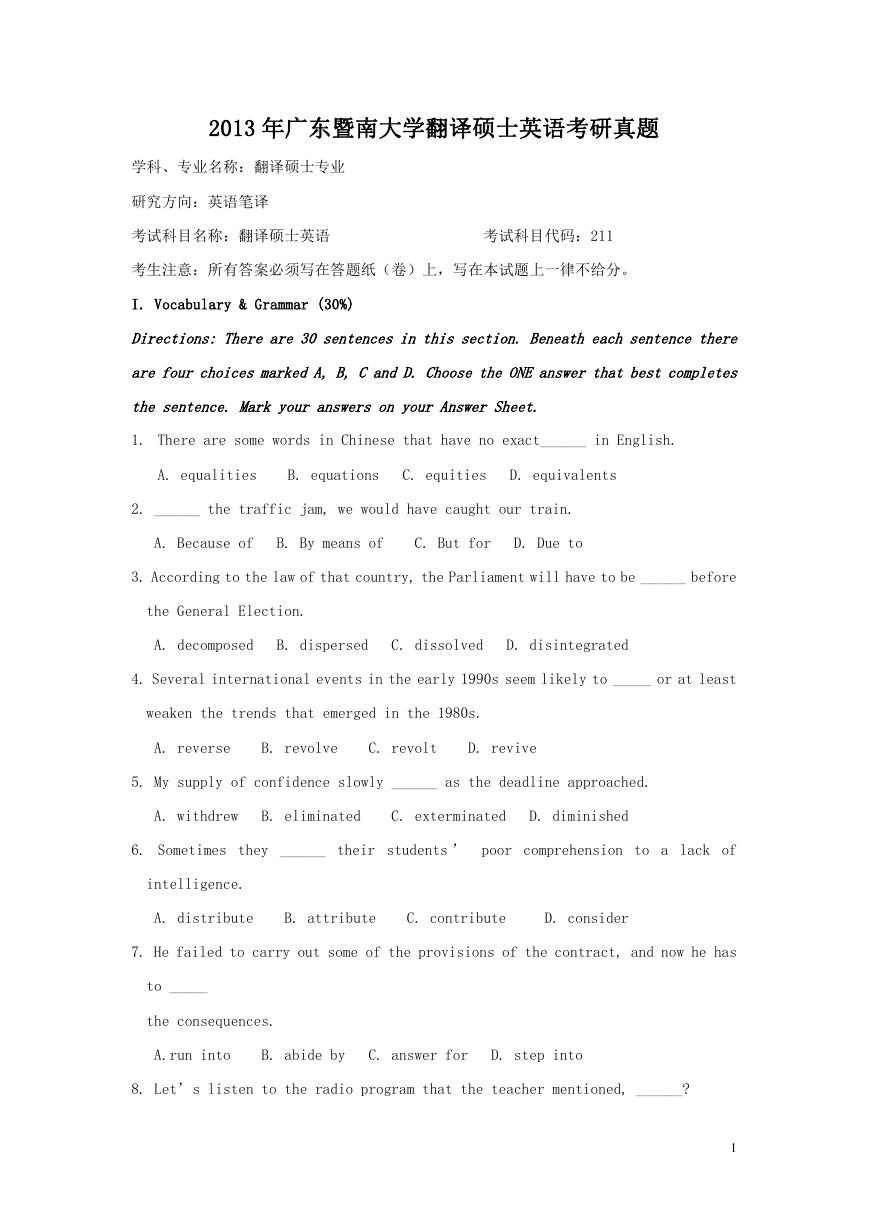
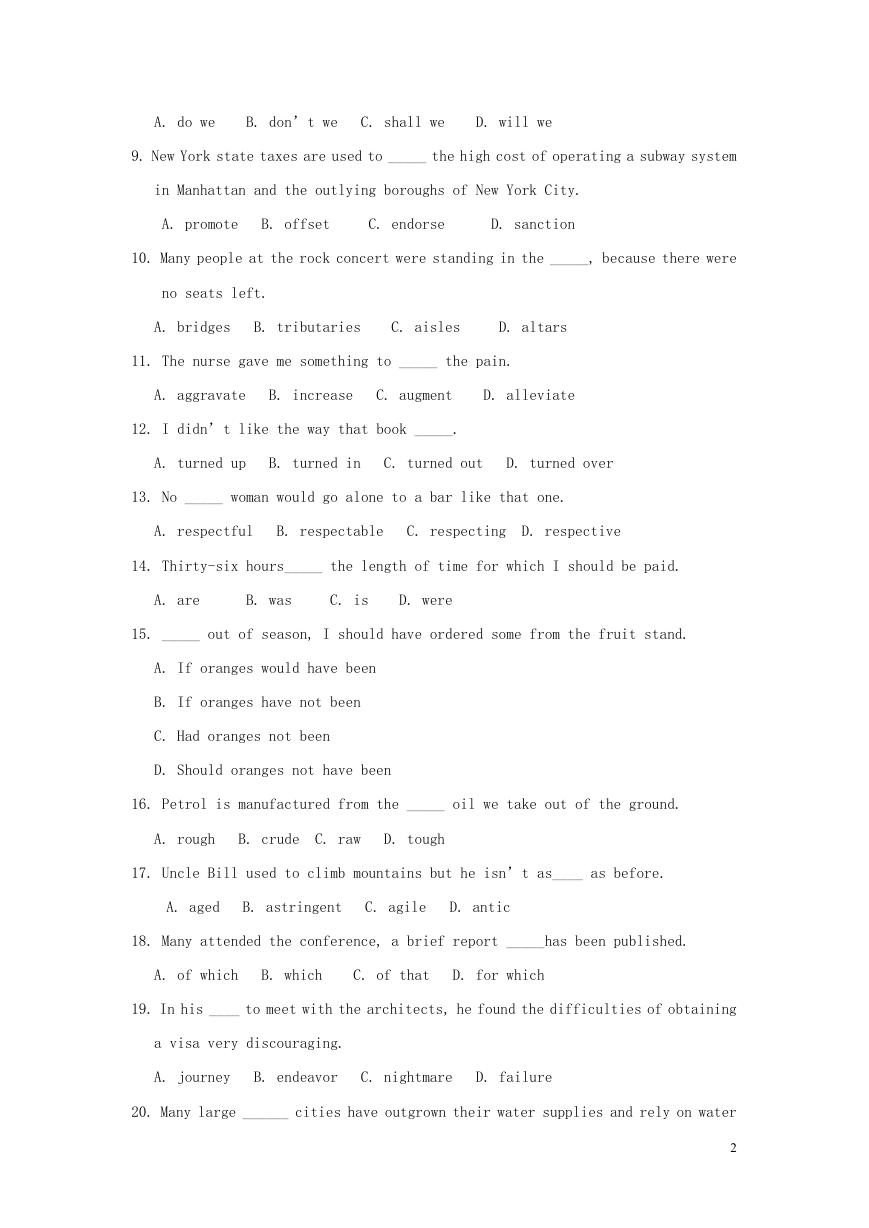
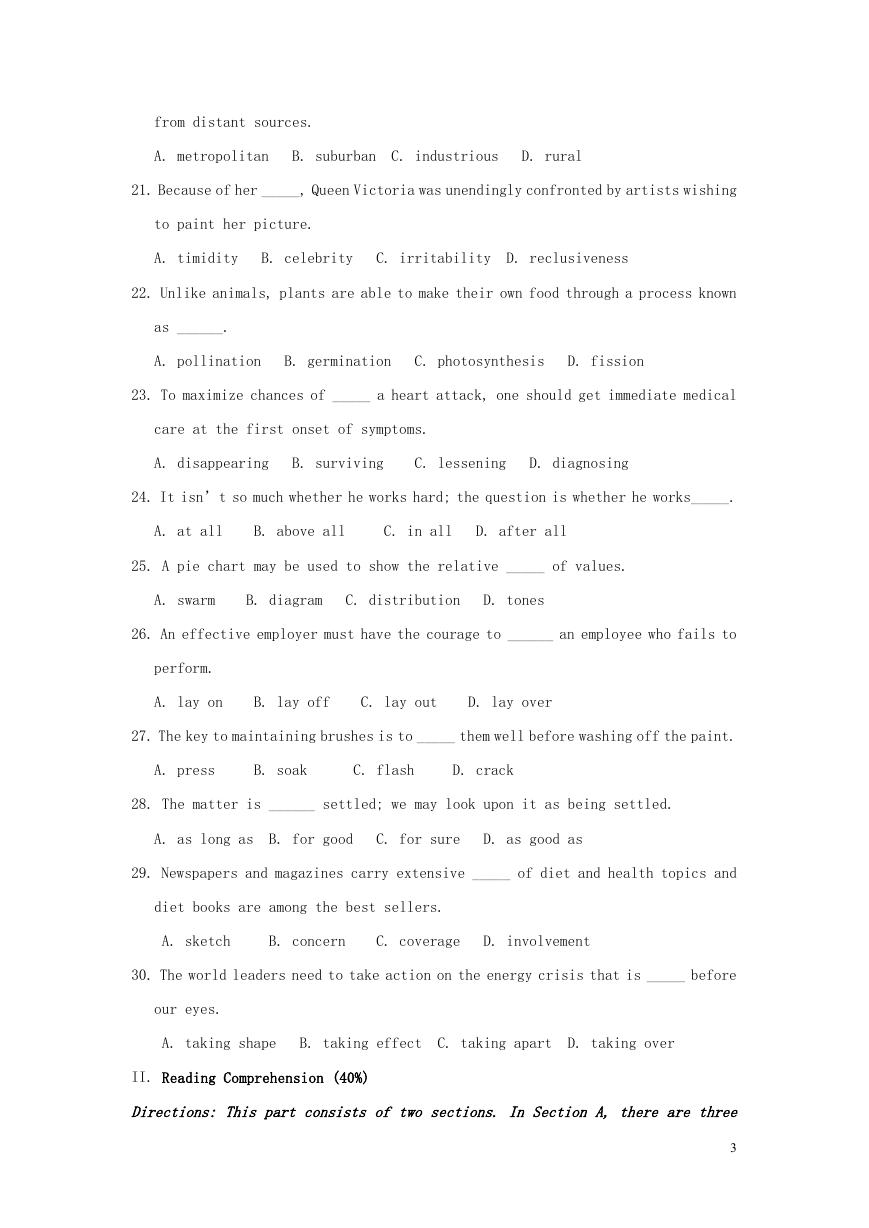
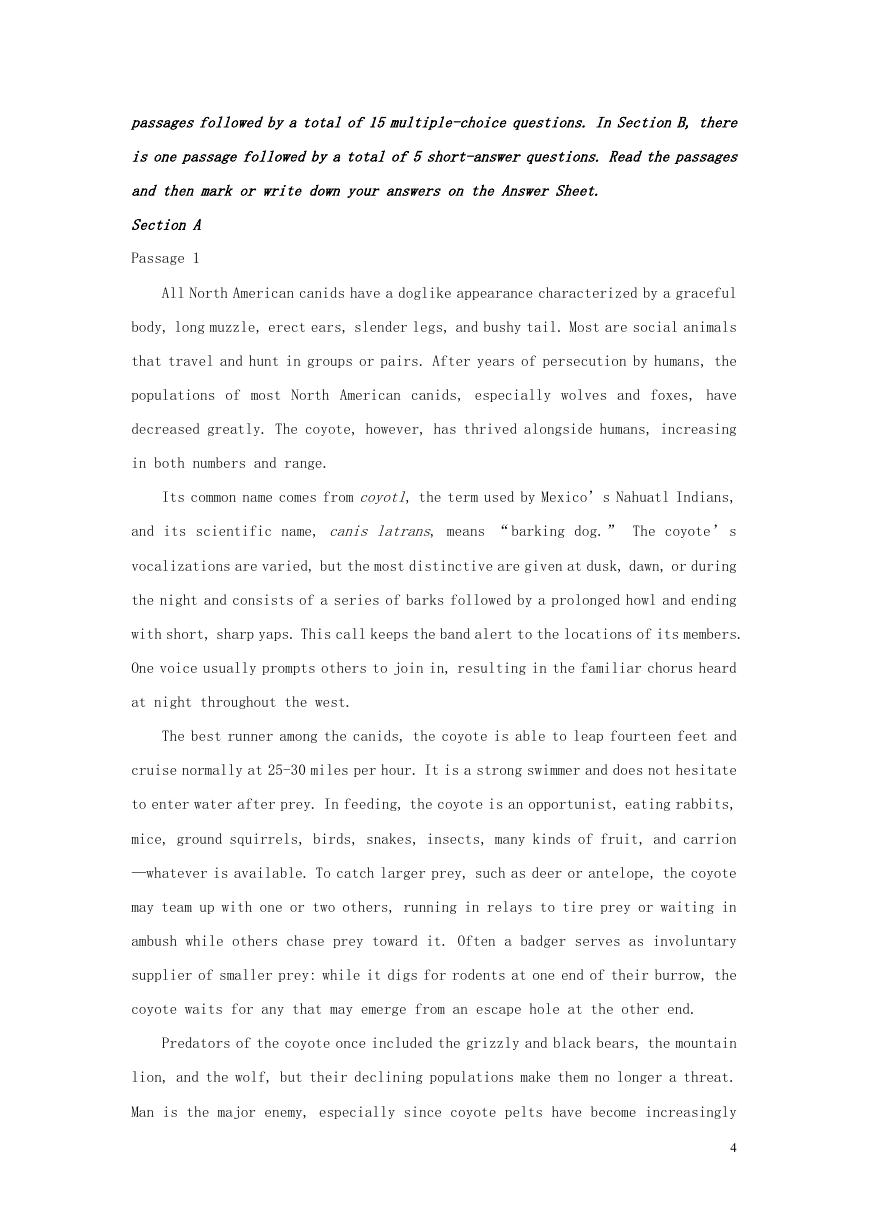
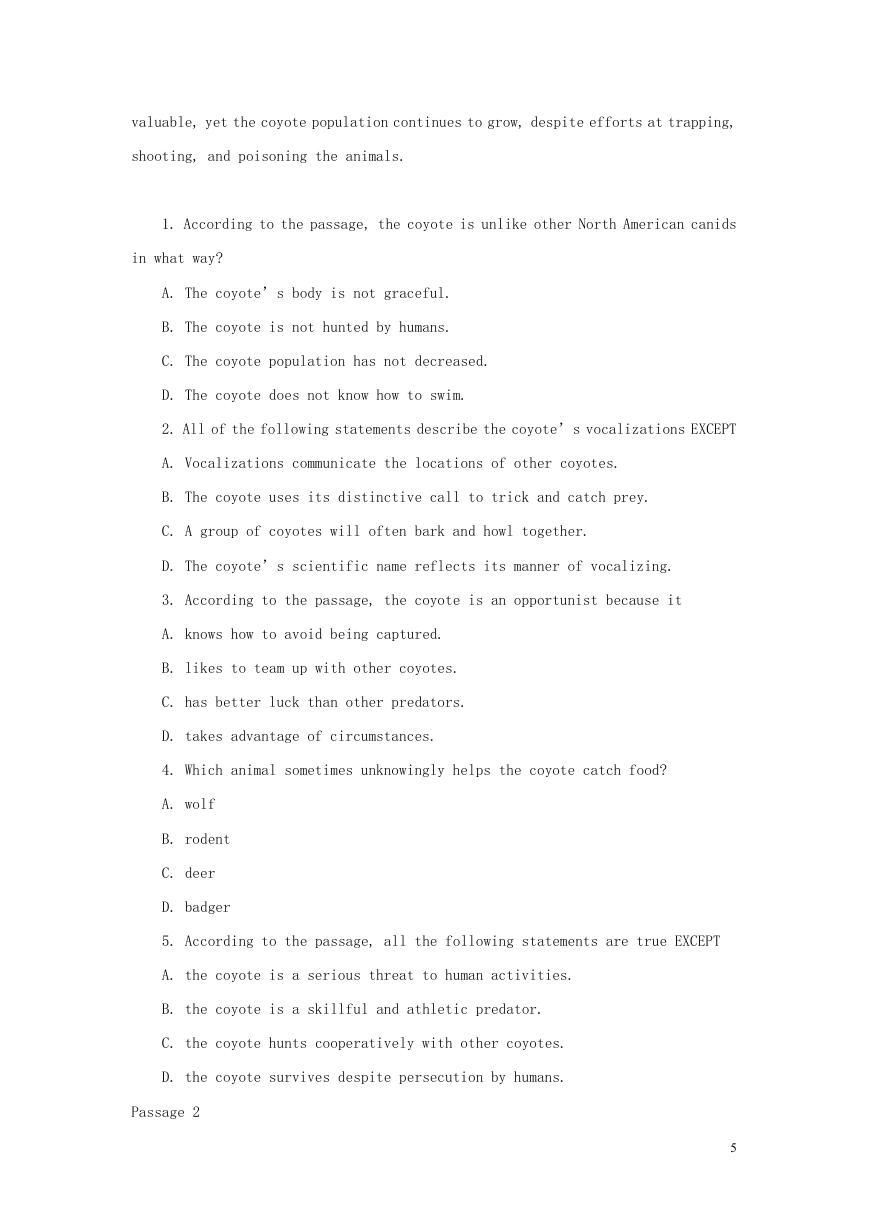
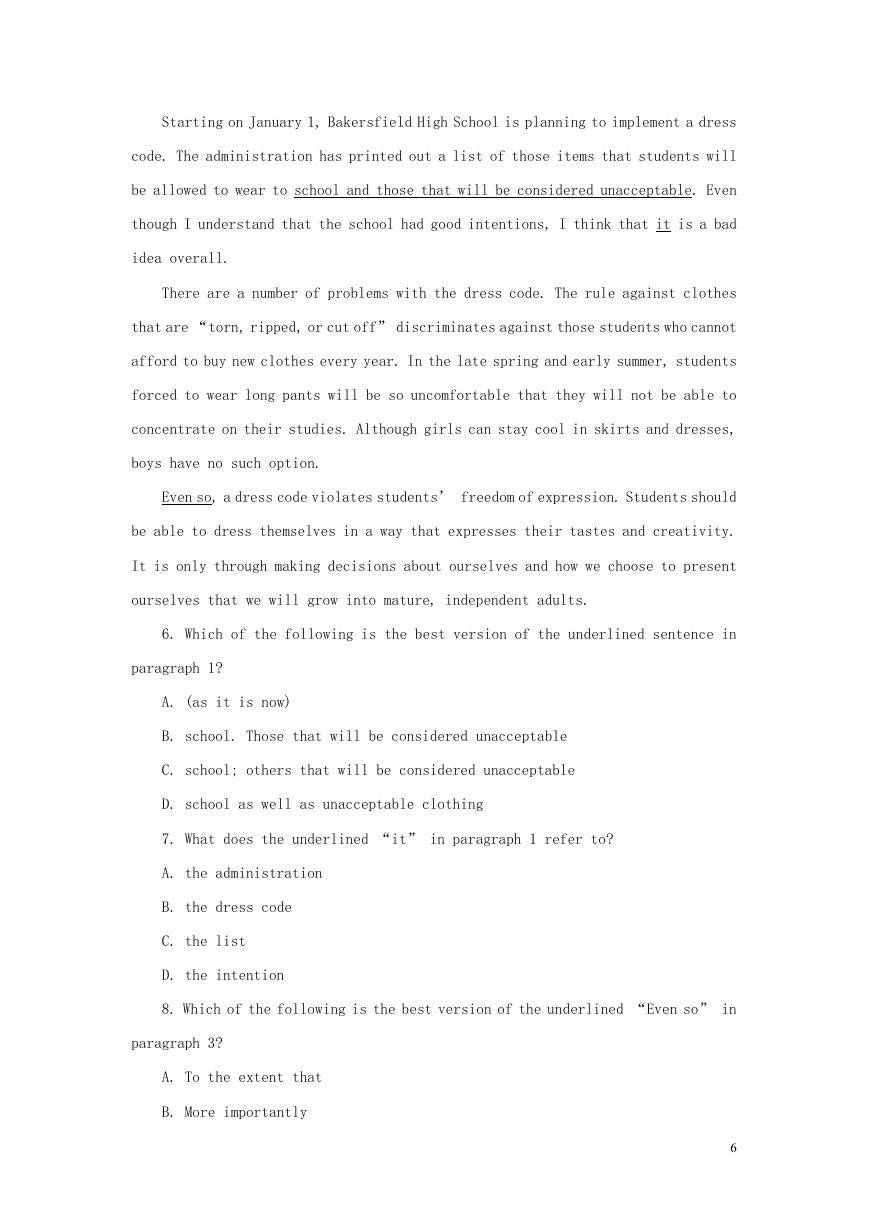
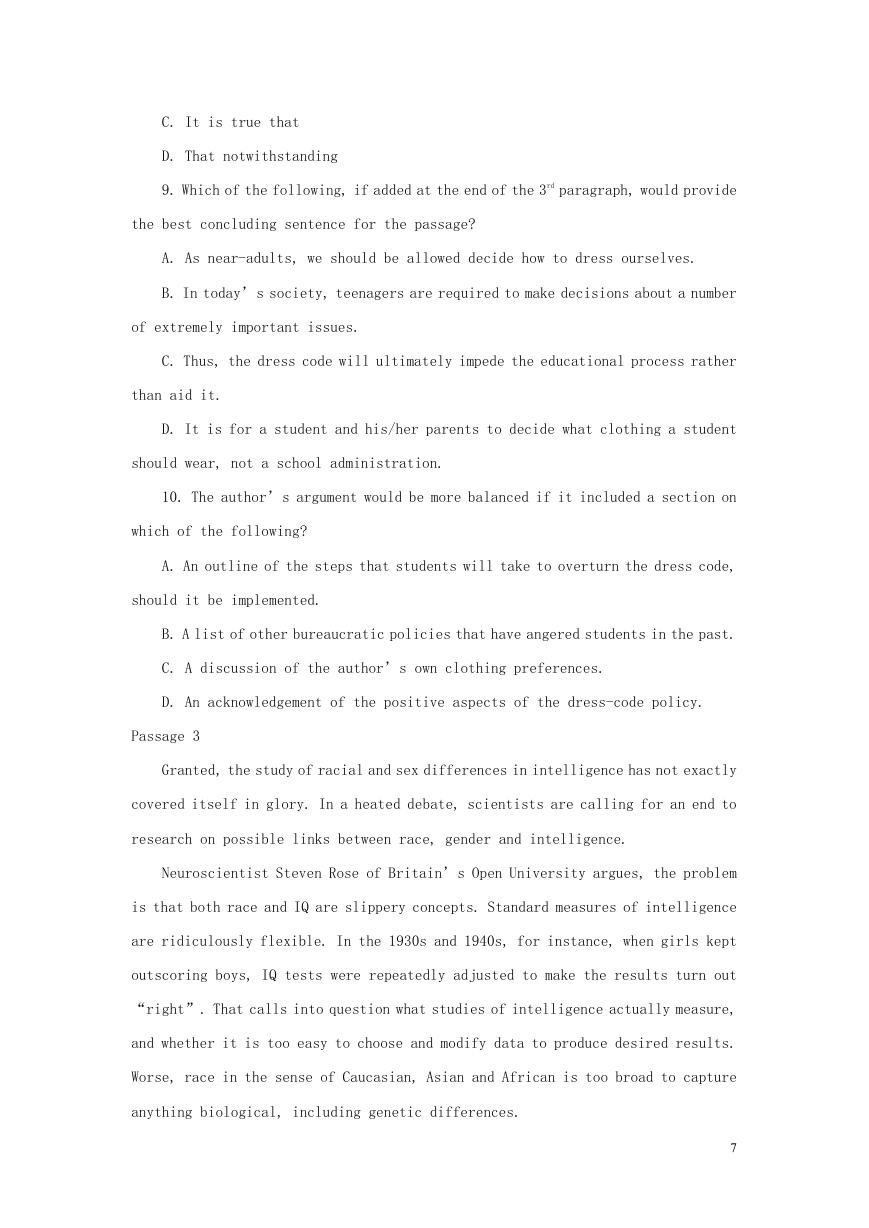
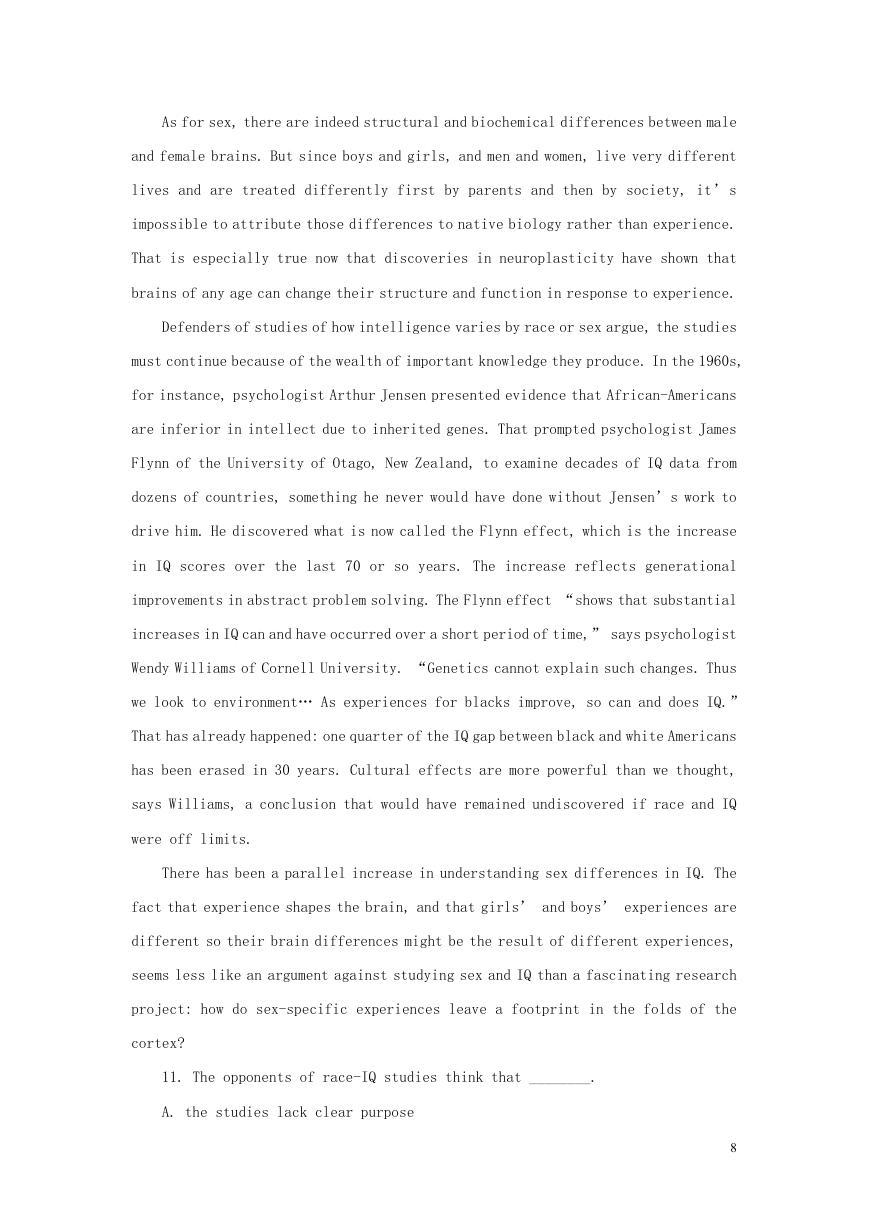








 2023年江西萍乡中考道德与法治真题及答案.doc
2023年江西萍乡中考道德与法治真题及答案.doc 2012年重庆南川中考生物真题及答案.doc
2012年重庆南川中考生物真题及答案.doc 2013年江西师范大学地理学综合及文艺理论基础考研真题.doc
2013年江西师范大学地理学综合及文艺理论基础考研真题.doc 2020年四川甘孜小升初语文真题及答案I卷.doc
2020年四川甘孜小升初语文真题及答案I卷.doc 2020年注册岩土工程师专业基础考试真题及答案.doc
2020年注册岩土工程师专业基础考试真题及答案.doc 2023-2024学年福建省厦门市九年级上学期数学月考试题及答案.doc
2023-2024学年福建省厦门市九年级上学期数学月考试题及答案.doc 2021-2022学年辽宁省沈阳市大东区九年级上学期语文期末试题及答案.doc
2021-2022学年辽宁省沈阳市大东区九年级上学期语文期末试题及答案.doc 2022-2023学年北京东城区初三第一学期物理期末试卷及答案.doc
2022-2023学年北京东城区初三第一学期物理期末试卷及答案.doc 2018上半年江西教师资格初中地理学科知识与教学能力真题及答案.doc
2018上半年江西教师资格初中地理学科知识与教学能力真题及答案.doc 2012年河北国家公务员申论考试真题及答案-省级.doc
2012年河北国家公务员申论考试真题及答案-省级.doc 2020-2021学年江苏省扬州市江都区邵樊片九年级上学期数学第一次质量检测试题及答案.doc
2020-2021学年江苏省扬州市江都区邵樊片九年级上学期数学第一次质量检测试题及答案.doc 2022下半年黑龙江教师资格证中学综合素质真题及答案.doc
2022下半年黑龙江教师资格证中学综合素质真题及答案.doc